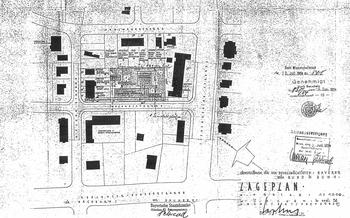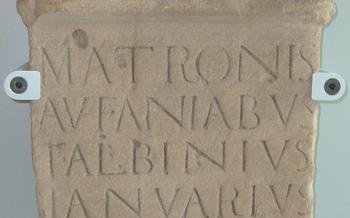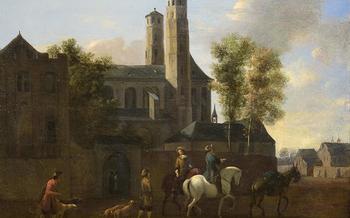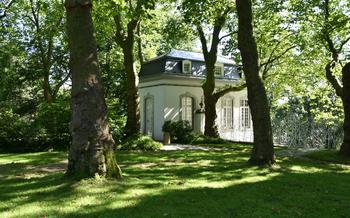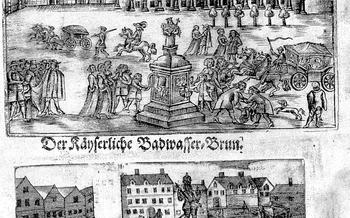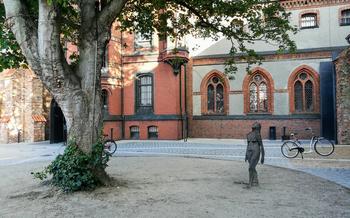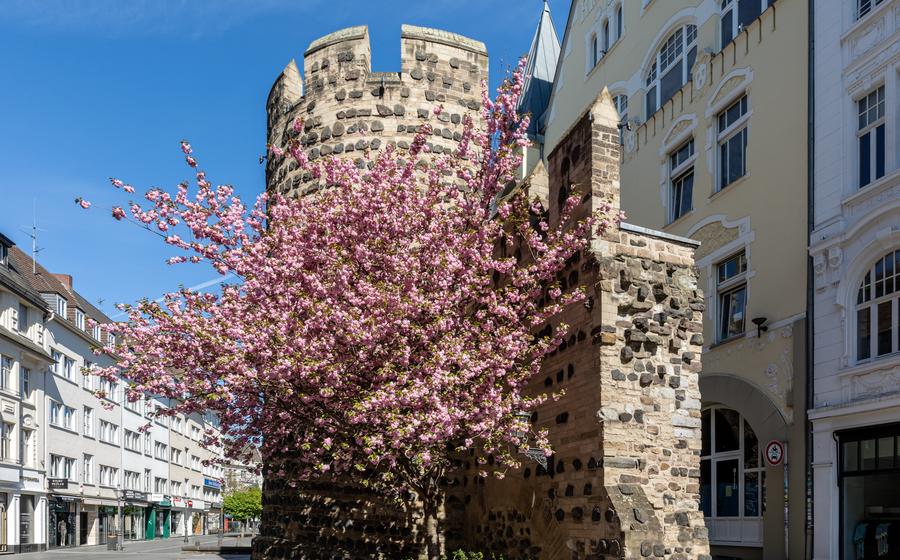
Roman Ruins at Ahrweiler
- Historical Significance
- Getting to Ahrweiler
- Ahrweiler's Charm
- The Ahrtor Gate: A Symbol of Ahrweiler's Enduring Legacy
- Ahrweiler Town Hall
- St. Peter's Church
- Stadtmauer Ahrweiler
- Ahr Valley Villages
- Walporzheim Abbey: A Legacy of Benedictine Spirituality and Cultural Revival
- Ahrtal Railway
- Burg Are: A Majestic Fortress Overlooking the Ahr Valley
- Die Welt der Schokoladen: Indulge in the Sweetest Treat
- Ahrweiler Wine Festival
- Insider Tip
Historical Significance
Bonn's rich history is deeply intertwined with Roman influences. As the capital of the Roman province of Germania Inferior, Bonn, known as Castra Bonnensia, served as a significant military and administrative center. During this period, the Romans constructed numerous fortifications, roads, and aqueducts, leaving a lasting impact on the region's infrastructure and urban development. The Roman ruins at Ahrweiler, located just a short distance from Bonn, offer a fascinating glimpse into this ancient past. These ruins, remnants of a Roman villa, provide tangible evidence of the Roman occupation and its profound effects on the region. Excavations at the site have uncovered well-preserved mosaics, wall paintings, and artifacts, shedding light on the daily lives and customs of the Roman inhabitants. A visit to these ruins offers a unique opportunity to explore the enduring legacy of the Roman Empire and its influence on Germany's cultural heritage.
Getting to Ahrweiler
Ahrweiler's Roman ruins beckon with their ancient allure, inviting you on a journey through time. Situated just 25 kilometers southwest of Bonn, the picturesque town of Ahrweiler is easily accessible by car or public transportation. For a leisurely drive, take the scenic route along the Ahr Valley, immersing yourself in the region's breathtaking landscapes. Alternatively, hop on the regional train from Bonn Hauptbahnhof, which offers a convenient and direct connection to Ahrweiler. Upon arrival, you'll find ample parking options in the town center, ensuring a hassle-free start to your exploration of Ahrweiler's Roman legacy.
Ahrweiler's Charm
The charm of Ahrweiler extends beyond its Roman heritage, captivating visitors with its idyllic ambiance and rich cultural offerings. The town's narrow streets are lined with beautifully preserved medieval buildings, many of which feature intricate carvings and colorful facades. These charming structures evoke a sense of history and transport visitors back in time.
Surrounding Ahrweiler, picturesque vineyards stretch across the landscape, creating a stunning backdrop for the town. Visitors can enjoy scenic walks through the vineyards, marveling at the lush greenery and the vibrant hues of the grapes. The surrounding hills offer breathtaking views of the Ahr Valley, inviting visitors to soak in the natural beauty of the region.
Ahrweiler's lively atmosphere and vibrant cultural scene add to its allure. Throughout the year, the town hosts various events, including wine festivals, concerts, and traditional markets. These events showcase local culture, offering visitors the chance to immerse themselves in the traditions and festivities of the region.
The Ahrtor Gate: A Symbol of Ahrweiler's Enduring Legacy
The Ahrtor Gate, or Ahrtor, stands as a testament to Ahrweiler's rich history and enduring legacy. Built in the 13th century as part of the city's fortifications, this impressive gate once served as the main entrance to the town. Its imposing structure, featuring a sturdy tower and fortified walls, reflects the strategic importance of Ahrweiler during medieval times.
Over the centuries, the Ahrtor Gate has witnessed countless events that shaped the city's destiny. It has stood as a silent observer to wars, sieges, and periods of prosperity. Despite the ravages of time and the destruction of many other fortifications, the Ahrtor Gate has remained remarkably well-preserved, thanks to meticulous restoration efforts.
Today, the Ahrtor Gate stands as a symbol of Ahrweiler's resilience and its deep connection to its past. It serves as a reminder of the city's origins and the importance of preserving its heritage. Visitors to Ahrweiler can admire the gate's intricate architectural details, including its crenellated tower, machicolations, and a portcullis, which once provided additional security.
As one passes through the Ahrtor Gate, they are transported back in time, entering a world of cobblestone streets, half-timbered houses, and medieval charm. This iconic landmark is not just a relic of the past but a living symbol of Ahrweiler's enduring spirit and its commitment to preserving its cultural heritage.
Ahrweiler Town Hall
Ahrweiler's Town Hall stands as a testament to the city's rich history and civic pride. Its Late Gothic architectural style, characterized by intricate stonework and pointed arches, dates back to the 16th century. The building served as the seat of local government, housing various administrative offices and playing a central role in community events.
Over the centuries, the Town Hall has undergone several renovations and expansions, reflecting Ahrweiler's evolving needs and architectural influences. Its distinctive facade features a blend of Gothic and Renaissance elements, with a central clock tower that dominates the town square. The interior boasts grand halls and council chambers, adorned with intricate frescoes and decorative woodwork that showcase the artistry of the era.
Today, the Ahrweiler Town Hall continues to serve as the heart of local government, housing the mayor's office and various administrative departments. It also remains a popular venue for weddings, cultural events, and community gatherings, symbolizing the enduring connection between the building and the people of Ahrweiler.
St. Peter's Church
A Journey Through Architectural Evolution
St. Peter's Church stands as a testament to Ahrweiler's rich architectural heritage. Originally built in the Romanesque style during the 12th century, it underwent significant transformations over the centuries, culminating in the addition of Gothic elements in the 15th century. This fusion of architectural styles creates a harmonious blend that is both visually striking and historically significant.
The most notable feature of St. Peter's Church is its tower, which soars above the town's skyline. Constructed in the Romanesque style, it features sturdy walls, arched windows, and a crenellated parapet. The choir, on the other hand, showcases the intricate details of the Gothic period, with its ribbed vaults, pointed arches, and delicate tracery.
Inside the church, visitors are greeted by an awe-inspiring display of stained-glass windows. These vibrant masterpieces depict biblical scenes and historical events, casting a radiant glow upon the interior. The intricate carvings and sculptures adorning the walls and pillars add another layer of artistic richness to the sacred space.
St. Peter's Church is not only an architectural marvel but also a place of deep religious significance. It has served as a spiritual sanctuary for the people of Ahrweiler for centuries, hosting countless baptisms, weddings, and funerals. Its towering presence reminds visitors of the enduring power of faith and the continuity of tradition in this charming town.
Stadtmauer Ahrweiler
Ahrweiler's medieval fortifications, known as the Stadtmauer Ahrweiler, once formed a protective barrier around the city. Constructed between the 13th and 15th centuries, these sturdy walls featured towers, gates, and ramparts, providing defense against potential invaders. While parts of the walls have been lost to the passage of time, significant sections remain, offering a glimpse into Ahrweiler's rich history.
The Engelsturm (Angel Tower), a well-preserved round tower, stands as a testament to the city's defenses. Another notable remnant is the Ahrtor, a fortified gate that once served as the main entrance to Ahrweiler. These surviving structures, along with the remaining wall segments, have been meticulously restored and maintained, ensuring their preservation for future generations.
Exploring the Stadtmauer Ahrweiler is a captivating experience, transporting visitors back to a time when fortifications were essential for the safety and security of medieval cities. Strolling along the preserved sections, one can imagine the bustling activity and challenges faced by the people of Ahrweiler during those tumultuous times.
Ahr Valley Villages
The charming villages nestled along the Ahr Valley offer a glimpse into the region's rich history and picturesque landscapes. Among these gems are Altenahr and Mayschoss, where time seems to stand still amidst enchanting half-timbered houses and cobblestone streets.
Altenahr captivates with its medieval flair, boasting a well-preserved castle that dominates the skyline. Immerse yourself in the village's history as you explore the ruins of the ancient castle, wander through the narrow lanes, and admire the intricate facades of the half-timbered houses.
Mayschoss exudes a serene charm, inviting you to unwind and savor the tranquility of the surroundings. Stroll along the idyllic streets lined with charming wine taverns and specialty shops, where you can sample local delicacies and discover unique handcrafted items.
Venture beyond these villages to uncover hidden gems like Dernau, Rech, and Marienthal, each offering its own unique character and charm. Whether you prefer exploring historic churches, visiting local wineries, or simply soaking in the breathtaking scenery, the Ahr Valley villages promise an unforgettable experience.
Walporzheim Abbey: A Legacy of Benedictine Spirituality and Cultural Revival
Walporzheim Abbey, nestled in the heart of Ahrweiler, stands as a testament to the enduring legacy of Benedictine monasticism and the region's rich cultural heritage. Founded in the 12th century by Archbishop Arnold I of Cologne, the abbey played a pivotal role in the spiritual and economic development of the Ahr Valley.
Over the centuries, Walporzheim Abbey served as a center of learning and piety, with its monks engaging in scholarly pursuits, tending to the sick, and providing spiritual guidance to the local community. The abbey's extensive vineyards and agricultural lands contributed significantly to the region's economy, fostering a tradition of viticulture that continues to flourish today.
The abbey's architectural grandeur reflects its historical significance. The Romanesque basilica, with its intricate carvings and soaring arches, is a masterpiece of medieval craftsmanship. The cloisters, with their serene atmosphere and delicate tracery, offer a glimpse into the contemplative life of the Benedictine monks.
After centuries of prosperity, Walporzheim Abbey faced its share of challenges. It was dissolved during the secularization of church property in the early 19th century, and its buildings fell into disrepair. However, in the late 20th century, a group of dedicated individuals undertook the ambitious task of restoring the abbey to its former glory.
Today, Walporzheim Abbey has been transformed into a vibrant cultural and event venue. The restored buildings house a museum dedicated to the history of the abbey and the Benedictine order, as well as a concert hall and conference facilities. Visitors can explore the abbey's beautifully landscaped grounds, admire the restored artwork, and delve into the rich history of this sacred site.
Walporzheim Abbey's revival as a cultural center is a testament to the enduring spirit of the Benedictine monks and the resilience of the Ahrweiler community. It stands as a symbol of the region's rich heritage and continues to play a vital role in preserving and promoting local culture.
Ahrtal Railway
Take a scenic journey through the picturesque Ahr Valley aboard the Ahrtal Railway. This historic rail line, dating back to the late 19th century, offers a charming and leisurely way to explore the region's stunning landscapes.
The train meanders along the Ahr River, passing through quaint villages, lush vineyards, and rolling hills. Marvel at the changing scenery as the train hugs the riverbanks, crosses over viaducts, and tunnels through rock formations.
The journey offers breathtaking views of the Ahr Valley's natural beauty. Admire the terraced vineyards clinging to steep slopes, the patchwork of forests and fields, and the shimmering river winding its way through the valley.
The Ahrtal Railway is not just a mode of transportation but also a nostalgic experience. Step back in time as you ride in vintage carriages, some of which date back to the early 20th century. The carriages are well-maintained and offer comfortable seating, ensuring a pleasant journey.
The Ahrtal Railway is a convenient and eco-friendly way to explore the Ahr Valley. Hop on and off at various stations to visit charming villages, hike through vineyards, or simply soak in the stunning scenery.
Whether you're a history buff, a nature lover, or simply looking for a unique travel experience, the Ahrtal Railway is a must-do in the Ahr Valley.
Burg Are: A Majestic Fortress Overlooking the Ahr Valley
Nestled amidst the picturesque vineyards of the Ahr Valley, Burg Are stands as a testament to the region's rich history and architectural heritage. Built in the 12th century by the Counts of Are, this imposing castle once served as a strategic stronghold, protecting the surrounding lands. Over the centuries, it underwent several expansions and modifications, reflecting the changing needs and tastes of its successive owners. Today, Burg Are stands as a magnificent example of medieval architecture, beckoning visitors to explore its storied past and admire its well-preserved features.
The castle's commanding position atop a hill offers breathtaking panoramic views of the Ahr Valley, with its lush vineyards, rolling hills, and meandering river. Visitors can wander through the castle's courtyards, marveling at its intricate stonework, imposing towers, and well-maintained fortifications. Despite the ravages of time and wars, Burg Are has undergone extensive restoration efforts, ensuring its preservation for future generations.
As you explore the castle's interior, you'll encounter a fascinating blend of medieval and modern elements. Admire the grand halls, each with its unique character, and imagine the lively banquets and gatherings that once took place within these walls. Don't miss the opportunity to climb to the top of the castle tower, where you'll be rewarded with unparalleled views of the surrounding countryside.
Burg Are is not just a historical monument but also a vibrant cultural venue. Throughout the year, it hosts a variety of events, including concerts, exhibitions, and medieval reenactments. These events bring the castle's history to life, allowing visitors to experience the grandeur and excitement of a bygone era. Whether you're a history buff, a nature lover, or simply seeking a unique and memorable experience, Burg Are promises an unforgettable visit.
Die Welt der Schokoladen: Indulge in the Sweetest Treat
Nestled in the heart of Ahrweiler, Die Welt der Schokoladen is a sensory haven for chocolate enthusiasts. This unique museum invites visitors to embark on a journey of taste, discovery, and imagination.
Chocolate enthusiasts will be in awe of the interactive exhibits, which showcase the history, cultivation, and production of chocolate. Learn about the origins of cocoa beans, trace the ancient trade routes, and witness the transformation of raw ingredients into mouthwatering treats.
But the true magic lies in the hands-on workshops, where visitors can unleash their inner chocolatier. Under the guidance of skilled artisans, you'll learn the art of chocolate making, from tempering and molding to decorating and packaging. Create your own personalized chocolate bars, truffles, and pralines, and savor the satisfaction of tasting your handcrafted creations.
Die Welt der Schokoladen is a paradise for families, offering an educational and entertaining experience for all ages. The museum's playful atmosphere and interactive exhibits captivate children's imaginations, making it a memorable and delicious outing.
So, step into the world of chocolate and indulge in a sensory extravaganza. Let the aroma of cocoa transport you to distant lands, and let the taste of rich, velvety chocolate melt away your worries. Die Welt der Schokoladen is a sweet escape that will leave you craving for more.
Ahrweiler Wine Festival
The annual Ahrweiler Wine Festival is a vibrant celebration of the region's wine-making heritage and local culture. Held in late September, the festival draws visitors from near and far to experience the unique charm of Ahrweiler and its surrounding vineyards.
The festival transforms the city into a lively hub of activity, with music, dancing, and traditional festivities filling the streets. Local vintners showcase their finest wines, offering tastings and opportunities to purchase bottles to savor at home.
Amidst the jovial atmosphere, visitors can indulge in delicious local cuisine, from hearty German dishes to sweet treats. Street vendors offer a variety of culinary delights, ensuring that there's something to satisfy every palate.
The Ahrweiler Wine Festival is a wonderful opportunity to immerse oneself in the vibrant culture of the Ahr Valley, celebrate the region's wine-making traditions, and create lasting memories in this charming German town.
Insider Tip
Beyond the main attractions, Ahrweiler offers hidden gems waiting to be discovered. Take a stroll down the narrow alleys to find charming courtyards, local boutiques, and traditional restaurants. Savor the region's culinary delights, such as the famous Ahrtaler Schinken (ham) and Ahrtaler Rotwein (red wine).
For a unique photo opportunity, head to the vineyards at sunset when the golden light casts a magical glow over the landscape. To avoid the crowds, plan your visit during the off-season or on a weekday. Join a guided tour to delve deeper into Ahrweiler's history and culture, and don't forget to bring comfortable shoes for exploring the cobblestone streets.
